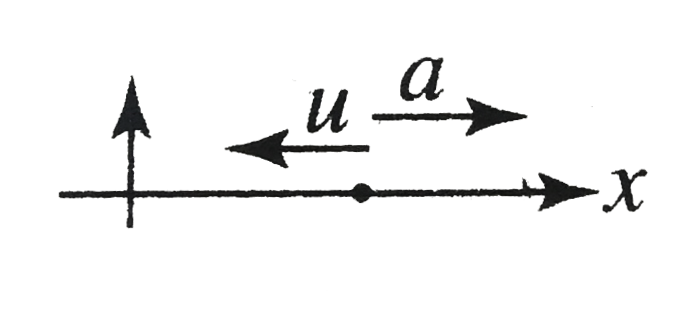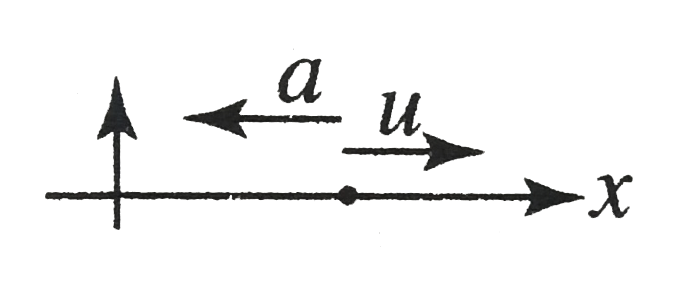The two ends of a train moving with constant acceleration pass a certain point with velocities u and 3u. The velocity with which the middle point of the train passes the same point is
2u
32u
√5u
√10u
The correct Answer is:C
To solve the problem, we need to determine the velocity of the middle point of the train as it passes a certain point, given that the two ends of the train pass that point with velocities u and 3u respectively.
1. Understanding the Problem:
- The front end of the train passes the observation point with velocity u.
- The rear end of the train passes the same point with velocity 3u.
- The train is moving with constant acceleration.
2. Identifying Variables:
- Let the length of the train be l.
- The initial velocity of the front end (engine) is u.
- The final velocity of the rear end is 3u.
3. Using the Kinematic Equation:
- We can use the equation of motion:
v2=u2+2as
- Here, v is the final velocity (which is 3u), u is the initial velocity (which is u), a is the acceleration, and s is the distance covered (which is the length of the train, l).
- Plugging in the values:
(3u)2=u2+2a(l)
9u2=u2+2al
- Rearranging gives:
8u2=2al⟹a=4u2l
4. Finding the Velocity of the Middle Point:
- The middle point of the train will pass the observation point when the front end has covered half the length of the train, i.e., l2.
- We need to find the velocity of the front end when it has covered this distance.
- Using the same kinematic equation:
v2=u2+2as
- Here, s=l2:
v2=u2+2(4u2l)(l2)
v2=u2+4u2=5u2
- Taking the square root gives:
v=√5u
5. Conclusion:
- The velocity with which the middle point of the train passes the observation point is √5u.
Final Answer:
The velocity with which the middle point of the train passes the same point is √5u.
---
- The front end of the train passes the observation point with velocity u.
- The rear end of the train passes the same point with velocity 3u.
- The train is moving with constant acceleration.
- Let the length of the train be l.
- The initial velocity of the front end (engine) is u.
- The final velocity of the rear end is 3u.
- We can use the equation of motion:
v2=u2+2as
- Here, v is the final velocity (which is 3u), u is the initial velocity (which is u), a is the acceleration, and s is the distance covered (which is the length of the train, l).
- Plugging in the values:
(3u)2=u2+2a(l)
9u2=u2+2al
- Rearranging gives:
8u2=2al⟹a=4u2l
- The middle point of the train will pass the observation point when the front end has covered half the length of the train, i.e., l2.
- We need to find the velocity of the front end when it has covered this distance.
- Using the same kinematic equation:
v2=u2+2as
- Here, s=l2:
v2=u2+2(4u2l)(l2)
v2=u2+4u2=5u2
- Taking the square root gives:
v=√5u
- The velocity with which the middle point of the train passes the observation point is √5u.
The velocity with which the middle point of the train passes the same point is √5u.
Topper's Solved these Questions
- MOTION IN A STRAIGHT LINEBOOK - AAKASH INSTITUTE ENGLISHCHAPTER - MOTION IN A STRAIGHT LINEEXERCISE - ASSIGNMENT (SECTION - B)
33 Videos
- MOTION IN A STRAIGHT LINEBOOK - AAKASH INSTITUTE ENGLISHCHAPTER - MOTION IN A STRAIGHT LINEEXERCISE - ASSIGNMENT (SECTION - C)
36 Videos
- MOTION IN A STRAIGHT LINEBOOK - AAKASH INSTITUTE ENGLISHCHAPTER - MOTION IN A STRAIGHT LINEEXERCISE - EXERCISE
29 Videos
- MOTION IN A PLANEBOOK - AAKASH INSTITUTE ENGLISHCHAPTER - MOTION IN A PLANEEXERCISE - Assignement section -J (Aakash Challengers Questions)
7 Videos
- MOTION IN STRAIGHT LINEBOOK - AAKASH INSTITUTE ENGLISHCHAPTER - MOTION IN STRAIGHT LINEEXERCISE - Assignment (SECTION - J)
2 Videos
Similar Questions
The two ends of a train moving with uniform acceleration pass a certain point with velocity u and v. Find the velocity with which the middle point of the train passes the same point.
View SolutionA train is moving with uniform acceleration. The two ends of the train pass through a point on the track with velocity v1 and v2. With what velocity the middle point of the train would pass through the same point ?
View SolutionThe engine of a train passes an electric pole with a velocity 'u' and the last compartment of the train crosses the same pole with a velocity v. Then find the velocity with which the mid-point of the train passes the pole. Assume acceleration to be uniform.
View SolutionEngine of a train that is moving with unifrom acceleration passes a pole with speed u while the last compartment passes the pole with speed 'v'. The middle point of the train passes the given pole with speed:
View SolutionA car moving with constant acceleration crosses two points A and B with velocities 10 m/s and 20 m/s in its path. Find the velocity of the car midway between A and B. (in m/s).
View SolutionA point moving with constant acceleration from A to B in the straight line AB has velocities u and v at A and B respectively. Find its velocity at C, the mid point of AB. Also show that if the time from A to C is twice that from C to B, then v=7u.
View SolutionAverage velocity of a particle moving in a straight line, with constant acceleration a and initial velocity u in first t seconds is.
View SolutionAverage velocity of a particle moving in a straight line, with constant acceleration a and initial velocity u in first t seconds is.
View SolutionThe diagram shows a train moving with constant velocity and a car moving towards the train with constant velocity. The engine driver measures the velocity of the car as v1 . The passenger sitting in the last compartment measures the velocity of the car as v2 . Which of the following statements is true?

View Solution

For a particle moving along straight line with constant acceleration (a), we define velocity of the particle with time as
v=u+at, (u=initial velocity)
Draw the velocity-time graph of the particle in following situations.
(i) Velocity is decresing with time (i.e., acceleration in negative)
(ii) Initial velocity is negative but acceleration is positive
View Solution
